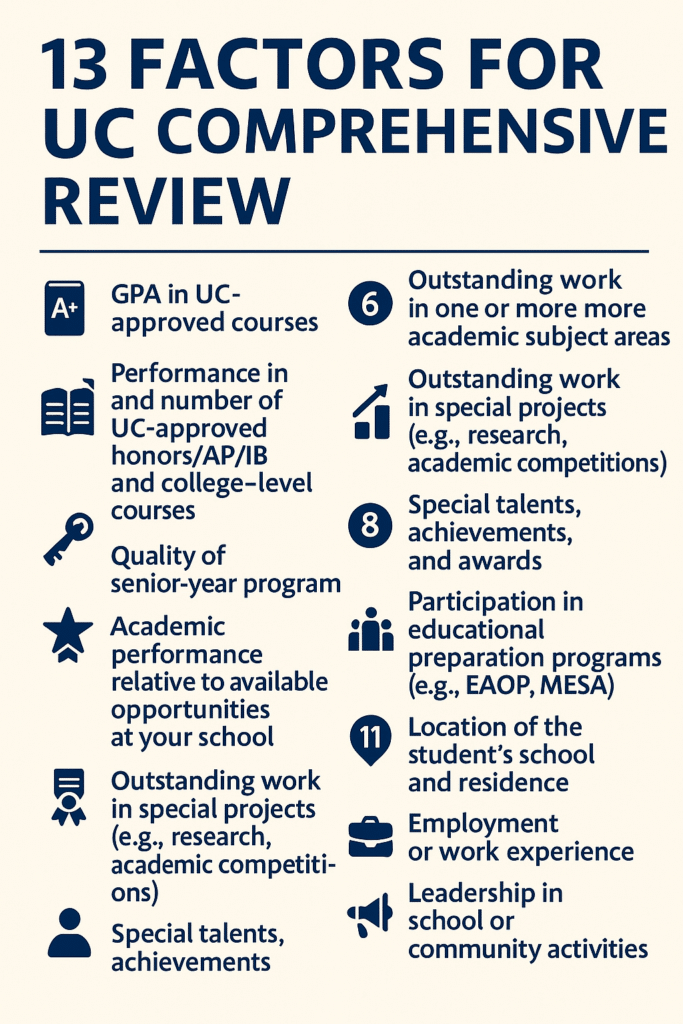Understanding the University of California Admissions Process
The University of California is one of the most respected public university systems in the world, with a commitment to access, excellence, and diversity. Every year, hundreds of thousands of students apply, and the UCs use a process called Comprehensive Review to evaluate applicants fairly and holistically. Understanding how this system works—and what UC readers are actually looking for—can help students craft more compelling applications and make more informed decisions.
What Is Comprehensive Review?
The UC Comprehensive Review process considers 13 distinct factors that together paint a picture of who you are as a student and a person. These factors are not weighed uniformly, and no one factor guarantees admission. Instead, each campus uses its own method of incorporating these criteria based on its applicant pool and institutional priorities.

The 13 Comprehensive Review Factors
- Academic GPA in all A–G courses, including additional points for UC-certified honors and AP/IB courses.
- Performance in academic courses beyond the A–G minimum—taking more rigorous coursework helps.
- Number of UC-approved honors/AP/IB courses completed and how well you performed in them.
- Eligibility in the Local Context (ELC)—whether you rank in the top 9% of your high school.
- Rigor of senior-year schedule, including advanced coursework planned or in progress.
- Academic performance in context—how well you performed given the opportunities available at your school.
- Achievement in specific academic subjects that shows intellectual depth or passion.
- Outstanding performance in academic projects, such as research, independent study, or specialized coursework.
- Marked improvement in academic performance, especially in recent semesters.
- Special talents, achievements, or awards, including arts, athletics, languages, leadership, and community service.
- Completion of special academic projects, either in class or through school-sponsored events.
- Academic accomplishments in light of personal circumstances—including low-income status, first-generation college status, or challenges faced.
- The location of your school and residence, which provides context for interpreting your achievements.
UC readers don’t just look at what you’ve done. They also look at how you’ve made use of what was available to you, and how your background and experiences shaped your academic path.
Why the Personal Insight Questions (PIQs) Matter
In a test-blind environment, PIQs are one of the most critical tools UC readers have to understand how a student thinks, acts, and grows. They help illuminate many of the judgment-based factors above, especially intellectual curiosity, leadership, impact, and resilience. Generic or off-topic answers won’t do you any favors. The best PIQs show what you’ve done, what you’ve learned, and why it matters.
The A–G Subject Requirements
To be eligible for admission, students must complete a minimum set of high school courses called the A–G requirements, with a minimum weighted GPA in those courses of 3.0:
- A: History/social science – 2 years
- B: English – 4 years
- C: Mathematics – 3 years (4 recommended)
- D: Laboratory science – 2 years (3 recommended)
- E: Language other than English – 2 years (3 recommended)
- F: Visual and performing arts – 1 year
- G: College-preparatory elective – 1 year
These are minimums. Many successful applicants go beyond them, especially in the A–E categories. For instance, UC Berkeley and UCLA often admit students who have taken four years each of math, science, and a language other than English.
Courses must be UC-approved, and for California students, you can check which courses at your high school qualify at UC’s A–G Course List.
What You Can Do Now
- Maximize your academic opportunities. Take the most challenging courses available to you and do well in them.
- Think strategically about your senior year. Don’t coast—UC readers pay close attention to your final year schedule.
- Tell your story effectively. Use the PIQs and activity descriptions to show leadership, initiative, impact, and resilience—not just participation.
- Context is key. Don’t worry about having every advantage—focus on showing how you’ve made the most of your circumstances.
Additional Resources:
- For a deeper dive into how UC admissions really work—including real examples and behind-the-scenes insights—read LifeLaunchr founder and CEO Venkates Swaminathan’s post here: What You Need to Know About the University of California Admissions Process.
- The UC’s Quick Reference Guide is an excellent resource for students and families seeking to understand the UC admissions process.